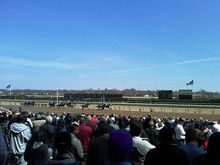An editorial on 9/28/2012, in the New York Times cites a report by a panel of experts regarding the alarming rise in thoroughbred fatalities last winter at Aqueduct Racetrack. The report said the lives of 11 of 21 horses that died at the track might have been saved if the state had had proper safeguards against over-medicated and substandard horses running for purses inflated by profits from the new adjacent casino at Aqueduct.

Spectators watching race at Aqueduct
Lives of 11 of 21 horses that died might have been saved if the state had proper safeguards against over-medicated and substandard horses running for purses inflated by profits.
© 2012 by Transpoman
The report, ordered by Gov. Andrew Cuomo, found considerable mismanagement of state racetracks by the New York Racing Association, particularly in leaving veterinarians’ reports on horse safety subject to overrule by racing officials. A new equine medical director’s office will be responsible for protecting horses, and the governor ordered far tighter controls on commonly abused racetrack medications. He also enlisted jockeys as whistle-blowers.
The report and the governor’s recommendations for reform were the strongest alarm yet about a growing national scandal in which the industry’s economic incentives find trainers, veterinarians and regulators cutting corners and putting horses at risk. An investigation by Joe Drape and Walt Bogdanich of The Times found that 24 horses a week die in breakdowns at American tracks — a rate higher than in countries with tougher penalties for drug abuse and for trainers caught violating regulations.
Mr. Cuomo previously moved to take control of the scandal-ridden racing association and protect the industry and state revenues at the Aqueduct, Belmont and Saratoga tracks. He is wise to heed the experts’ report as an urgent warning that far tighter controls for horse safety are needed to prevent further compromise of racing’s integrity.
